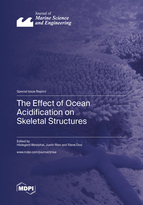The Effect of Ocean Acidification on Skeletal Structures
A special issue of Journal of Marine Science and Engineering (ISSN 2077-1312). This special issue belongs to the section "Geological Oceanography".
Deadline for manuscript submissions: closed (5 April 2023) | Viewed by 16594
Special Issue Editors
2. Department of Geosciences, Bremen University, Fahrenheit Str.6, D-28359 Bremen, Germany
Interests: carbonate sedimentology; sea-level change; ocean acidification; nutrification; PALECOLOGY
Interests: ocean acidification; global warming; global oceanic change; calcium carbonate; biomineralization; limestone; paleoceanography
Special Issue Information
Dear Colleagues,
Increasing atmospheric CO2 concentrations have led to a decrease in ocean pH, known as ocean acidification (OA). The effect of OA on calcium carbonate precipitation and subsequent potential dissolution in carbonate depositional systems such as coral reefs is a hotly debated topic, in particular as complex and partly contrasting effects are observed. The Special Issue aims to bring together current knowledge on OA in carbonate depositional ecosystems in perspective and review papers, and the latest research results, to provide a basis for this ongoing discussion. These ecosystems include but are not limited to coral reefs, oyster reefs, calcifying algae (maerl beds), etc. in which calcifiers are the predominant reef engineer. Thus, we invite contributions on new research outcomes in skeletal precipitation and structure (from individuals to communities), physiological mechanisms that underpin complex host and symbiont interactions, and responses of heterotrophic and phototrophic calcifiers (e.g., calcification rates, stability of skeletons, encrustation, and cementation) under projected OA conditions. The goal is to contribute to a better understanding of what to expect for the future of carbonate depositional systems, resilience, and potential avenues for counteracting negative effects on calcification triggered by increasing CO2 concentrations.
We especially encourage early-career researchers from Global South countries to submit their findings to this Special Issue.
High-quality papers are encouraged for publication related to various aspects, as mentioned below:
- Influence on CO2 on marine calcification;
- Trophic strategies and their relation to OA effects;
- Physiology behind calcification under OA conditions;
- Experimental approaches;
- Field approaches;
- Earth history analogues;
- Developments in analytical techniques to study skeletal structures in the context of OA.
If you are interested in contributing to the Special Issue but may not able to meet the deadline, please do not hesitate to contact us. As we aim for an interesting compilation of state-of-the-art and novel insights, we invite you to contribute your view to this growing Special Issue.
Prof. Dr. Hildegard Westphal
Prof. Dr. Justin Ries
Dr. Steve Doo
Guest Editors
Manuscript Submission Information
Manuscripts should be submitted online at www.mdpi.com by registering and logging in to this website. Once you are registered, click here to go to the submission form. Manuscripts can be submitted until the deadline. All submissions that pass pre-check are peer-reviewed. Accepted papers will be published continuously in the journal (as soon as accepted) and will be listed together on the special issue website. Research articles, review articles as well as short communications are invited. For planned papers, a title and short abstract (about 100 words) can be sent to the Editorial Office for announcement on this website.
Submitted manuscripts should not have been published previously, nor be under consideration for publication elsewhere (except conference proceedings papers). All manuscripts are thoroughly refereed through a single-blind peer-review process. A guide for authors and other relevant information for submission of manuscripts is available on the Instructions for Authors page. Journal of Marine Science and Engineering is an international peer-reviewed open access monthly journal published by MDPI.
Please visit the Instructions for Authors page before submitting a manuscript. The Article Processing Charge (APC) for publication in this open access journal is 2600 CHF (Swiss Francs). Submitted papers should be well formatted and use good English. Authors may use MDPI's English editing service prior to publication or during author revisions.
Keywords
- Ocean acidification
- Coral reefs
- Calcification
- Carbonate depositional systems
- Skeletal structure
- Resilience
- Effects on ecosystems and biodiversity








